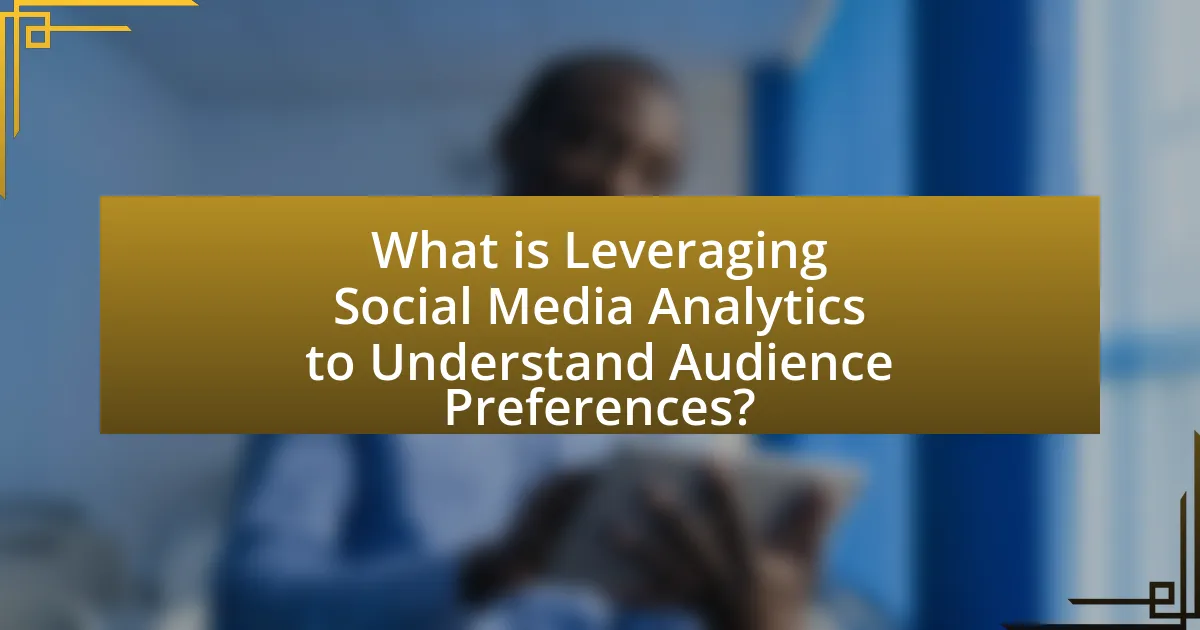Leveraging social media analytics to understand audience preferences involves the use of data from social media platforms to gain insights into user behaviors, interests, and needs. This process enables businesses to tailor their marketing strategies and content to align with audience values, enhancing customer satisfaction and loyalty. Key aspects include analyzing engagement metrics, demographic information, and sentiment analysis to identify trends that inform product development and marketing strategies. Effective tools and techniques, such as Hootsuite and Google Analytics, are essential for gathering and interpreting this data, while best practices emphasize the importance of clear objectives and continuous monitoring of audience engagement metrics.

What is Leveraging Social Media Analytics to Understand Audience Preferences?
Leveraging social media analytics to understand audience preferences involves utilizing data collected from social media platforms to gain insights into the behaviors, interests, and needs of users. This process enables businesses to tailor their marketing strategies and content to better align with what their audience values. For instance, analytics tools can track engagement metrics such as likes, shares, and comments, revealing which types of content resonate most with specific demographics. According to a report by Hootsuite, 73% of marketers believe that social media data is crucial for understanding their audience, highlighting the importance of data-driven decision-making in marketing strategies.
How does social media analytics contribute to understanding audience preferences?
Social media analytics significantly contributes to understanding audience preferences by providing data-driven insights into user behavior and engagement patterns. By analyzing metrics such as likes, shares, comments, and demographic information, businesses can identify trends and preferences that inform content strategy. For instance, a study by Sprout Social found that 70% of consumers feel more connected to brands with a strong social media presence, indicating that engagement metrics directly reflect audience interests. This data allows companies to tailor their messaging and offerings to better align with what their audience values, ultimately enhancing customer satisfaction and loyalty.
What types of data are collected through social media analytics?
Social media analytics collects various types of data, including engagement metrics, demographic information, sentiment analysis, and content performance. Engagement metrics encompass likes, shares, comments, and click-through rates, providing insights into how users interact with content. Demographic information reveals user characteristics such as age, gender, and location, which helps in understanding the audience better. Sentiment analysis assesses the emotional tone of user-generated content, indicating public perception of brands or topics. Content performance data evaluates which posts resonate most with the audience, guiding future content strategies. These data types are essential for businesses to tailor their marketing efforts and enhance audience engagement.
How is audience behavior analyzed using social media data?
Audience behavior is analyzed using social media data through techniques such as sentiment analysis, engagement metrics, and demographic profiling. Sentiment analysis evaluates user-generated content to determine emotional responses, while engagement metrics, like likes, shares, and comments, quantify interaction levels with posts. Demographic profiling utilizes user data to segment audiences based on age, location, and interests, allowing for targeted insights. Research indicates that 79% of marketers believe social media data is crucial for understanding audience preferences, highlighting its significance in shaping marketing strategies.
Why is understanding audience preferences important for businesses?
Understanding audience preferences is crucial for businesses because it directly influences product development, marketing strategies, and customer engagement. By analyzing audience preferences, businesses can tailor their offerings to meet specific needs, leading to increased customer satisfaction and loyalty. For instance, a study by McKinsey & Company found that companies that effectively leverage customer insights can achieve a 10-15% increase in sales. This demonstrates that understanding what customers want not only enhances the relevance of products and services but also drives revenue growth.
What impact does audience understanding have on marketing strategies?
Audience understanding significantly enhances marketing strategies by enabling targeted messaging and personalized content. When marketers comprehend their audience’s preferences, behaviors, and demographics, they can tailor their campaigns to resonate more effectively. For instance, a study by HubSpot found that personalized emails can generate six times higher transaction rates compared to non-personalized emails. This demonstrates that a deep understanding of the audience leads to improved engagement and conversion rates, ultimately driving business success.
How can audience preferences influence product development?
Audience preferences significantly influence product development by guiding design, features, and marketing strategies. Companies analyze social media analytics to identify trends, sentiments, and specific needs expressed by their target audience. For instance, a study by McKinsey & Company found that organizations that leverage customer insights in product development can achieve up to 30% higher customer satisfaction rates. By integrating feedback from social media platforms, businesses can adapt their offerings to better align with consumer desires, ultimately leading to increased market relevance and sales.

What tools and techniques are used in social media analytics?
Social media analytics utilizes various tools and techniques to gather, analyze, and interpret data from social media platforms. Key tools include Hootsuite for scheduling and monitoring posts, Google Analytics for tracking website traffic from social media, and Sprout Social for comprehensive social media management and reporting. Techniques such as sentiment analysis, which assesses public opinion by analyzing text data, and engagement metrics, which measure likes, shares, and comments, are essential for understanding audience preferences. These tools and techniques enable businesses to make data-driven decisions, enhancing their marketing strategies and improving customer engagement.
Which social media analytics tools are most effective?
The most effective social media analytics tools include Hootsuite, Sprout Social, and Google Analytics. Hootsuite provides comprehensive social media management and analytics, allowing users to track engagement metrics across multiple platforms. Sprout Social offers in-depth reporting features and audience insights, which help businesses understand their audience preferences better. Google Analytics, while primarily a web analytics tool, integrates with social media platforms to provide valuable data on traffic sources and user behavior. These tools are widely recognized for their effectiveness in helping businesses analyze social media performance and audience engagement.
What features should businesses look for in social media analytics tools?
Businesses should look for features such as real-time data tracking, audience demographics analysis, engagement metrics, sentiment analysis, and competitive benchmarking in social media analytics tools. Real-time data tracking allows businesses to monitor their social media performance instantly, enabling timely adjustments to strategies. Audience demographics analysis provides insights into the characteristics of followers, helping tailor content to specific groups. Engagement metrics, including likes, shares, and comments, measure how well content resonates with the audience. Sentiment analysis evaluates public perception of a brand, which is crucial for reputation management. Competitive benchmarking compares a business’s performance against industry peers, offering context for growth and improvement. These features collectively enhance a business’s ability to understand audience preferences and optimize social media strategies effectively.
How do these tools integrate with existing marketing platforms?
These tools integrate with existing marketing platforms through APIs and data connectors that facilitate seamless data exchange. For instance, social media analytics tools can pull engagement metrics directly from platforms like Facebook or Twitter and push insights into marketing automation systems such as HubSpot or Marketo. This integration allows marketers to create targeted campaigns based on real-time audience preferences and behaviors, enhancing overall marketing effectiveness. According to a report by Gartner, organizations that effectively integrate analytics into their marketing strategies can see a 20% increase in campaign performance.
What techniques can be employed to analyze audience preferences?
Techniques to analyze audience preferences include social media sentiment analysis, engagement metrics evaluation, and demographic segmentation. Social media sentiment analysis utilizes natural language processing to gauge audience emotions and opinions expressed in posts and comments, providing insights into preferences. Engagement metrics evaluation involves analyzing likes, shares, and comments to determine which content resonates most with the audience, indicating their interests. Demographic segmentation categorizes the audience based on age, gender, location, and interests, allowing for tailored content that aligns with specific audience segments. These techniques are validated by studies showing that targeted content based on audience preferences increases engagement and satisfaction.
How can sentiment analysis be used to gauge audience feelings?
Sentiment analysis can be used to gauge audience feelings by analyzing text data from social media, reviews, and other online platforms to determine the emotional tone expressed. This technique employs natural language processing algorithms to classify sentiments as positive, negative, or neutral, allowing organizations to quantify audience reactions to products, services, or events. For instance, a study by Liu (2012) in “Sentiment Analysis and Opinion Mining” highlights how sentiment analysis can reveal consumer attitudes, enabling businesses to tailor their marketing strategies based on audience feedback.
What role does engagement metrics play in understanding preferences?
Engagement metrics are crucial for understanding audience preferences as they provide quantifiable data on how users interact with content. These metrics, such as likes, shares, comments, and click-through rates, reveal what resonates with the audience, allowing marketers to tailor their strategies accordingly. For instance, a study by HubSpot found that content with higher engagement rates correlates with increased audience retention and loyalty, indicating that understanding these metrics can lead to more effective content creation and audience targeting.

How can businesses apply insights from social media analytics?
Businesses can apply insights from social media analytics by tailoring their marketing strategies to align with audience preferences and behaviors. By analyzing engagement metrics, sentiment analysis, and demographic data, companies can identify trends and preferences that inform product development, content creation, and targeted advertising. For instance, a study by Sprout Social found that 70% of consumers are more likely to engage with brands that understand their preferences, highlighting the importance of leveraging social media insights to enhance customer relationships and drive sales.
What strategies can be developed from audience insights?
Strategies developed from audience insights include targeted content creation, personalized marketing campaigns, and improved customer engagement. Targeted content creation involves analyzing audience demographics and preferences to produce relevant material that resonates with specific segments, thereby increasing engagement rates. Personalized marketing campaigns leverage insights to tailor messages and offers to individual preferences, which can enhance conversion rates; for instance, studies show that personalized emails can lead to a 29% higher open rate. Improved customer engagement strategies utilize insights to foster two-way communication, allowing brands to respond to audience feedback and preferences in real-time, which can strengthen brand loyalty and customer satisfaction.
How can targeted marketing campaigns be designed using audience data?
Targeted marketing campaigns can be designed using audience data by analyzing demographic, behavioral, and psychographic information to tailor messages and offers. This process involves collecting data from social media analytics, which provides insights into audience preferences, engagement patterns, and interests. For instance, a study by HubSpot found that personalized emails based on audience data can increase click-through rates by 14% and conversion rates by 10%. By segmenting the audience based on this data, marketers can create specific campaigns that resonate with each group, thereby enhancing the effectiveness of their marketing efforts.
What are the best practices for implementing audience-driven strategies?
The best practices for implementing audience-driven strategies include utilizing social media analytics to gather data on audience preferences, segmenting the audience based on demographics and behavior, and continuously testing and optimizing content based on audience feedback. Social media analytics tools, such as Facebook Insights and Twitter Analytics, provide valuable metrics that help identify what content resonates with specific audience segments. Research shows that companies using audience segmentation see a 10-20% increase in engagement rates, demonstrating the effectiveness of tailored strategies. Additionally, regularly analyzing performance data allows for agile adjustments to campaigns, ensuring alignment with audience interests and maximizing impact.
What challenges might businesses face when leveraging social media analytics?
Businesses face several challenges when leveraging social media analytics, including data overload, integration issues, and interpreting metrics accurately. Data overload occurs when companies collect vast amounts of information from various platforms, making it difficult to extract actionable insights. Integration issues arise when businesses struggle to combine social media data with other data sources, leading to fragmented analysis. Additionally, interpreting metrics accurately can be challenging, as businesses may misinterpret engagement rates or sentiment analysis, resulting in misguided strategies. According to a report by the Content Marketing Institute, 70% of marketers find it difficult to measure the effectiveness of their social media efforts, highlighting the complexity of accurately leveraging social media analytics.
How can data privacy concerns affect social media analytics?
Data privacy concerns can significantly limit the effectiveness of social media analytics by restricting the data that can be collected and analyzed. When users are apprehensive about how their personal information is used, they may opt out of data sharing or provide inaccurate information, leading to incomplete datasets. For instance, regulations like the General Data Protection Regulation (GDPR) in Europe impose strict guidelines on data collection and user consent, which can hinder the ability of companies to gather comprehensive insights from social media platforms. This limitation can result in less accurate audience segmentation and targeting, ultimately affecting marketing strategies and campaign effectiveness.
What common pitfalls should businesses avoid in their analytics approach?
Businesses should avoid the common pitfalls of relying on incomplete data, neglecting data quality, and failing to align analytics with business objectives. Incomplete data can lead to misleading insights, as decisions based on partial information may not accurately reflect audience preferences. Neglecting data quality undermines the reliability of analytics; for instance, inaccurate or outdated data can skew results and lead to poor strategic choices. Additionally, failing to align analytics with business objectives results in wasted resources, as insights may not translate into actionable strategies that drive growth. According to a study by McKinsey, organizations that prioritize data quality and alignment with business goals are 5-6 times more likely to achieve significant improvements in performance.
What are the best practices for leveraging social media analytics effectively?
The best practices for leveraging social media analytics effectively include setting clear objectives, utilizing the right tools, and regularly analyzing data to inform strategy. Clear objectives guide the analytics process, ensuring that the data collected aligns with specific goals, such as increasing engagement or driving conversions. Utilizing tools like Google Analytics, Hootsuite, or Sprout Social allows for comprehensive data collection and analysis, providing insights into audience behavior and preferences. Regular analysis of metrics such as engagement rates, reach, and demographics enables businesses to adapt their strategies based on real-time feedback, ultimately enhancing audience understanding and improving content relevance. According to a report by HubSpot, companies that analyze their social media performance are 1.5 times more likely to achieve their marketing goals, highlighting the importance of effective analytics practices.
How can businesses continuously improve their understanding of audience preferences?
Businesses can continuously improve their understanding of audience preferences by leveraging social media analytics to gather real-time insights into consumer behavior. By analyzing engagement metrics, sentiment analysis, and demographic data from platforms like Facebook, Twitter, and Instagram, businesses can identify trends and shifts in audience interests. For instance, a study by Sprout Social found that 70% of consumers feel more connected to brands that engage with them on social media, indicating that active monitoring and interaction can enhance understanding of preferences. Additionally, utilizing tools like Google Analytics and social listening software allows businesses to track user interactions and feedback, enabling them to adapt their strategies based on concrete data.
What metrics should be regularly monitored to ensure effective audience engagement?
To ensure effective audience engagement, key metrics to monitor include engagement rate, reach, impressions, and audience growth rate. The engagement rate, calculated by dividing the total engagement (likes, shares, comments) by total followers, provides insight into how well content resonates with the audience. Reach indicates the number of unique users who see the content, while impressions measure how often the content is displayed, regardless of clicks. Audience growth rate tracks the increase in followers over time, reflecting the effectiveness of engagement strategies. Regularly analyzing these metrics allows for data-driven adjustments to content and strategy, enhancing overall audience interaction and satisfaction.

Leave a Reply